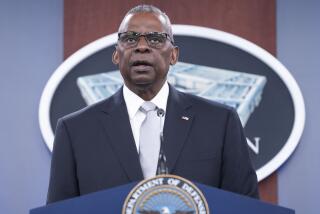Captain Tells of Desperate Efforts to Stop Iraqi Attack : Radar Gave No Warning of Missiles
- Share via
MANAMA, Bahrain — The captain of the U.S. Navy frigate Stark said today that his crew had just seconds warning and was activating anti-missile defenses when the first of two Iraqi missiles smashed into the frigate.
Capt. Glenn R. Brindel, in his first public statement on the Iraqi attack which killed 37 of his crew, said at a dramatic news conference: “We did not realize a missile had been fired until it was too late to engage it.”
Brindel said his crew was activating anti-missile defenses in the seconds after a lookout spotted an incoming projectile and phoned his warning to the ship’s Combat Information Center.
The captain said he was in the vicinity of the center when the first missile struck, knocking out electronic equipment. Efforts were being made to reactivate the equipment when a second projectile hit about 30 seconds later.
Both Hit Below Bridge
Both missiles smashed into the port side of the Stark below the bridge, turning two crew compartments and the combat center into infernos.
Brindel repeated statements made Tuesday by the commander of U.S. ships in the Persian Gulf, Rear Adm. Harold J. Bernsen, that the frigate had no reason to expect an Iraqi attack.
“There are numerous sorties of (Mirage) F-1 aircraft from Iraq, fighter aircraft from Iran that commonly come down through the gulf and pass within close distances of our ships and ships of other allied navies,” Brindel said.
“As long as there is no hostile intent shown by those aircraft towards the ship, our rules of engagement would provide that we do not take those aircraft under fire.”
Tracked 200 Miles
Brindel said the ship had a track on the Iraqi F-1 from 200 or more miles away from the Stark.
Two warnings were radioed to the approaching aircraft, but the ship received no response, he said. It was two to three minutes between the time the second warning was sent and the plane launched its missiles.
After the second warning, actions were taken to heighten weapons systems, but the close-in Phalanx anti-missile gun was only being switched from manual to automatic fire after the lookout spotted the approaching projectile, he said.
There had been no radar indication that the aircraft had launched missiles or that they were locked on to the ship, he said.
Risk of Accidental Shooting
Brindel said he knew one missile was a French-made Exocet from bits found on the Stark. But it was not clear whether the plane had first launched an undetected laser-guided projectile.
He said the Phalanx had been in a manual mode to prevent it shooting down an approaching aircraft automatically.
“General quarters” was sounded to put the crew on full battle alert as soon as it was realized that the ship was under attack, he said.
Asked how the missiles could penetrate all the defensive systems, Brindel said it was a difficult question to answer.
“Certainly in wartime an incoming aircraft such as the Iraqi F-1 would have been engaged at maximum missile range and would have been shot down without any problem,” he said.
Question Asked on Blame
Asked if he blamed himself for what had happened, the captain said: “I don’t know whether any of it was my fault, I don’t know whether it was the fault of an operator, I don’t know whether it was the fault of the equipment, I don’t know whether it was an act of God. . . .
The Stark limped into Bahrain under tow Tuesday night and tied up to a barge moored alongside the command ship LaSalle, flagship of the U.S. Mideast Force.
In Baghdad, Iraqi Foreign Minister Tariq Aziz said the pilot who attacked the Stark believed he was firing on an Iranian vessel and had received no warnings from the U.S. ship.
More to Read
Sign up for Essential California
The most important California stories and recommendations in your inbox every morning.
You may occasionally receive promotional content from the Los Angeles Times.













